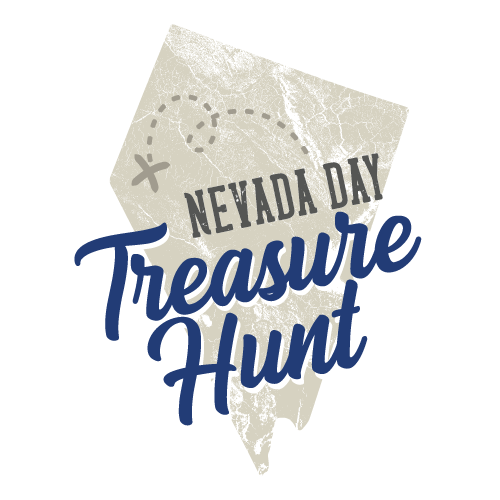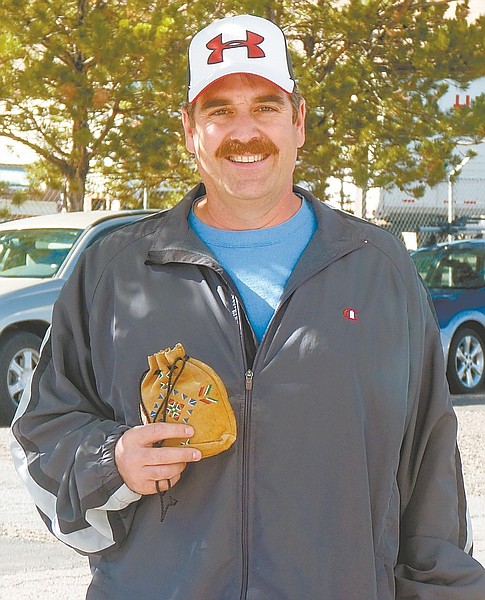Bernard Cihigoyenetche found the medallion after 13 clues along the fence line & across the road from Wilson-Commons Park in Fraktown.
Explanations for the 2012 Nevada Day Treasure Hunt Clues
Clue No. 1
To the heroism of
The military men and women
Past, present, and future
This hunt is respectfully dedicated
Explanation: The opening clue pays tribute to the theme of Nevada Day in 2012 – Honoring Our Military & Families Past, Present, Future …
Clue No. 2
When you go hunting
Always plan in advance
Don’t act too quickly
And never fly by the seat of your pants
Explanation: Hunters are encouraged to look beyond the obvious in each clue. It also gives an early hint of the treasure’s hiding place with its veiled reference to a Work Project Administration accomplishment –building a fly-proof outhouse at the Twaddle-Pedroli Ranch in Washoe Valley. It was one of several built in the “Nevada Fly-Proof Privy Program” in the late 1930s. Clever hunters may see the connection between this clue and Clue 13, which refers to the Works Project Administration.
Clue No. 3
An easy roll
Leads to the goal
Five beside four
Reveal even more
Explanation: Seven is the easiest roll in the game of craps and is also the number of counties in which the treasure may be hidden. Five of the treasure hunt counties touch the county lines of four other treasure hunt counties –Carson, Churchill, Mineral, Storey and Washoe. This clue eliminates Douglas and Lyon as possible locations.
Clue No. 4
Three meet up‘
Neath calico eyes
And consume their share
Of a wall of pies
Explanation: Humboldt, Pershing and Washoe Counties come together in Hualapai Flats (pronounced wall-a-pie). The Calico Mountains look down on the Flats from the north. Since Humboldt and Pershing are not counties included in the hunt, this narrows the field to Washoe County.
Clue No. 5
A hanging, a séance
An injustice, she cried
Was a deathbed confession
The truth or a lie
Explanation: In 1878 J.W. Rover was hanged on the grounds of the Washoe County Courthouse for the murder of his business partner, Isaac Sharp. After the hanging, a “seer” by the name of Eilley Orrum Bowers, who with her husband built Bowers Mansion, claimed that Rover’s spirit came to her and maintained his innocence. Newspaper articles later claimed that Rover’s other business partner, Frank McWorthy, confessed to Sharp’s murder on his deathbed. Some say that the articles amounted to rumor but the story has persisted through the years. The clue again points to Washoe County but insightful hunters should also catch the reference to Washoe Valley where Bowers Mansion is located.
Clue No. 6
Set out on adventure
Just like Quatermain
And while en-route, the map
Will mysteriously look the same
Explanation: This clue refers to the adventures of Allan Quatermain, as told in the classic novels written by Rider Haggard. In the 1885 adventure, “King Solomon’s Mines,” Quatermain searches for Ophir, a mysterious place of biblical legend that was the source of much gold. The novel contains a crude, hand-drawn map leading Quatermain through a mountain pass to a raised and fertile valley called Kukuanaland. At the northernmost point is the mouth of a treasure cave. The fictitious map looks somewhat akin to a map leading from Carson City through the hills of the Carson Range into Washoe Valley. Near the northern end of Washoe Valley, the Ophir Mill once stood. It was built on the West Shore of Washoe Lake by the Ophir Mining Company to process the ore produced by the Comstock Ophir Mine. This clue specifically points hunters to the Washoe Valley.
Clue No. 7
Slogging might leave you
Strapped for time
A nuke might move you
With this rhyme
Explanation: Slogging or schlogging is a windsurfing term that refers to slowly sailing a short board in a light wind. Strap Time is also a term that windsurfers use when they are describing how much time they were able to windsurf when their foot was strapped to the board. A nuke (or nukin’) is windsurfing slang for an extremely strong wind or rush of wind. Windsurfing is a popular sport on Washoe Lake on the east side of the Washoe Valley.
Clue No. 8
How did they travel
From booming to bloomed
Their progress is logged
And nearby entombed
Explanation: Washoe City was once a booming town that served as the seat of Washoe County. Decreased demand for the services provided by smelters and sawmills in the valley, along with the transfer of the county seat to Reno in 1871, contributed to the city’s decline. One of the few remnants of Washoe City’s heyday is a granite building that now houses a plant nursery. In 1961, the town’s 100-year history was documented in snapshots, documents, maps and other memorabilia that was sealed in a time capsule and placed inside a monument near the nursery and the entrance to Washoe Estates near the northeast shore of Washoe Lake.
Clue No. 9.
In any language
From winter to spring
The 89 champion
The river king
Explanation: In Spanish, the river king is El Rio Rey. This is the name of the racehorse that was the American Champion Two-Year-Old Colt in 1889. His master was Theodore Winters who owned a 4,000 acre cattle ranch in the Washoe Valley and ran unsuccessfully for governor of Nevada in 1890. The ranch is located near the northwest shore of Washoe Lake.
Clue No. 10
The laws of economics seem
To continue to confound
But truth be told; know one thing
Supply went up and price came down
Explanation: In the 1800s, an old prospector by the name of Price periodically loaded supplies and covertly took them up Slide Mountain. Local legend says he had a hidden mine on the mountain, but to this day the Lost Price Mine has never been found. Two reservoirs on the mountain were later named for him. In 1983, after an unusually wet winter and warm spring, an avalanche of boulders displaced the water from Upper Price Lake. It breached the dam of Lower Price Lake and sent a torrent of water, boulders and debris down the mountain and into the northwest section of Washoe Valley.
Clue No. 11
Between Wabuska and Potosi
There stands a tree of fruit
Find the buried treasure
And you can win the loot
Explanation: On the numbered list of Nevada historical markers, Wabuska in Lyon County is Number 113 and Potosi in Clark County is Number 115. Between them is Number 114, Franktown, which was named for local resident Frank Poirier. His surname is French and means “pear tree.” Franktown is located on the west side of Washoe Valley, south of Slide Mountain.
Clue No. 12
Her family name
Had an explosive beginning
She was unhappy
But you’ll be the one grinning
Explanation: As described in the book “The Divorce Seekers” by William L. and Sandra McGee, many wealthy easterners, European royalty and Hollywood celebrities came to the Washoe Valley to visit the Flying M.E. Ranch. They often stayed for six weeks in order to meet the Nevada residency requirement for a quickie divorce. Among them was Ethel du Pont Roosevelt whose family initially made their fortune manufacturing gunpowder. The Flying M.E. Ranch is south of Franktown and is visible from the treasure’s hiding spot.
Clue No. 13
Millions employed
By Frank and Harry
Building many a bridge
A school, a road, a library
Explanation: This clue refers to the Works Progress Administration, later renamed the Works Project Administration. Part of Franklin D. Roosevelt’s New Deal, it was headed by Harry Hopkins and provided jobs to millions during the Great Depression. As referenced in Clue 2, one of the WPA’s projects was the “Nevada Fly-Proof Privy Program,” and one of these innovative outhouses was constructed on the Twaddle-Pedroli Ranch in the Washoe Valley, south of the Flying M.E. Ranch and just a short distance from where the treasure is hidden.

